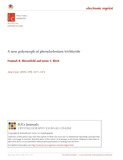| dc.contributor.author | Bloomfield, Hannah R. | |
| dc.contributor.author | Ritch, Jamie S. | |
| dc.date.accessioned | 2019-10-30T20:53:02Z | |
| dc.date.available | 2019-10-30T20:53:02Z | |
| dc.date.issued | 2019-11 | |
| dc.identifier.citation | Bloomfield, H. R.; Ritch, J. S. Acta Cryst. (2019). C75, 1471–1474 | en_US |
| dc.identifier.issn | 2053-2296 | |
| dc.identifier.uri | http://hdl.handle.net/10680/1743 | |
| dc.description.abstract | A second polymorph of phenylselenium trichloride, PhSeCl3 or C6H5Cl3Se, is
disclosed, which is comprised of asymmetric chlorine-bridged noncovalent
dimer units rather than polymeric chains. These dimers are each weakly bound
to an adjacent dimer through noncovalent Se...Cl bonding interactions. Phenyl
rings within each dimer are oriented in a syn fashion. Density functional theory
(DFT) calculations reveal that the putative anti isomer is within 5 kJ mol-1 of
the experimentally observed form. This structure represents the first additional
polymorph discovered for an organoselenium trihalide compound. | en_US |
| dc.description.uri | https://doi.org/10.1107/S2053229619013019 | en_US |
| dc.language.iso | en | en_US |
| dc.publisher | International Union of Crystallography | en_US |
| dc.rights | info:eu-repo/semantics/openAccess | en_US |
| dc.subject | selenium compound | en_US |
| dc.subject | polymorph | en_US |
| dc.subject | phenylselenium trichloride | en_US |
| dc.subject | crystal structure | en_US |
| dc.subject | chalcogen-halogen interaction | en_US |
| dc.subject | chemistry | en_US |
| dc.subject | crystallography | en_US |
| dc.title | A new polymorph of phenylselenium trichloride | en_US |
| dc.type | Article | en_US |
| dc.rights.license | Author(s) of this article may load this reprint on their own web site or institutional repository provided that
this cover page is retained. Republication of this article or its storage in electronic databases other than as
specified above is not permitted without prior permission in writing from the IUCr. | en_US |
| dc.identifier.doi | 10.1107/S2053229619013019 | en_US |

